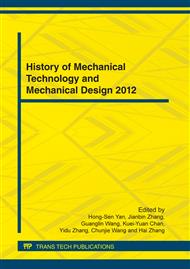[1]
Y. Takeda and Y. Kajikawa, Optics: a bibliometric approach to detect emerging research domains and intellectual bases, Scientometrics, vol. 78, no. 3, p.543–558, (2009).
DOI: 10.1007/s11192-007-2012-5
Google Scholar
[2]
X. Y. An and Q. Q. Wu, Co-word analysis of the trends in stem cells field based on subject heading weighting, Scientometrics, vol. 88, pp.133-144, Apr. (2011).
DOI: 10.1007/s11192-011-0374-1
Google Scholar
[3]
Y. Lee, S. Tsou, C. Lin, H. Ien and T. Wu, Global Perspective of Health Related Edible Plants from Agricultural Point of View, Asia Pac J Clin Nutr, vol. 17, no. 1, p.95–98, (2008).
Google Scholar
[4]
H. Schwechheimer and M. Winterhager, Mapping interdisciplinary research fronts in neuroscience: A bibliometric view to retrograde amnesia, Scientometrics, vol. 51, no. 1, p.311–318, (2001).
Google Scholar
[5]
Y. Kajikawa and Y. Takeda, Citation network analysis of organic LEDs, Technological Forecasting and Social Change, vol. 76, no. 8, p.1115–1123, (2009).
DOI: 10.1016/j.techfore.2009.04.004
Google Scholar
[6]
B. Cornelius, H. Landström, and O. Persson, Entrepreneurial studies: The dynamic research front of a developing social science, Entrepreneurship Theory and Practice, vol. 30, no. 3, p.375–398, (2006).
DOI: 10.1111/j.1540-6520.2006.00125.x
Google Scholar
[7]
H. Small, Tracking and predicting growth areas in science, Scientometrics, vol. 68, no. 3, p.595–610, (2006).
DOI: 10.1007/s11192-006-0132-y
Google Scholar
[8]
F. Åström, Changes in the LIS research front- Time-sliced cocitation analyses of LIS journal articles, 1990–2004, Journal of the American Society for Information Science and Technology, vol. 58, pp.947-957, (2007).
DOI: 10.1002/asi.20567
Google Scholar
[9]
N. Shibata, Y. Kajikawa, Y. Takeda, I. Sakata, and K. Matsushima, Detecting emerging research fronts in regenerative medicine by the citation network analysis of scientific publications, Technological Forecasting and Social Change, (2010).
DOI: 10.1016/j.techfore.2010.07.006
Google Scholar
[10]
S. A. Morris, G. Yen, Z. Wu, and B. Asnake, Time line visualization of research fronts, Journal of the American Society for Information Science and Technology, vol. 54, no. 5, p.413–422, (2003).
DOI: 10.1002/asi.10227
Google Scholar
[11]
A. A. Kayal and R. C. Waters, An empirical evaluation of the technology cycle time indicator as a measure of the pace of technological progress in superconductor technology, Engineering Management, IEEE Transactions on, vol. 46, no. 2, p.127–131, (1999).
DOI: 10.1109/17.759138
Google Scholar
[12]
N. Shibata, Y. Kajikawa and I. Sakata, Extracting the commercialization gap between science and technology - Case study of a solar cell, Technological Forecasting and Social Change vol. 77, pp.1147-1155, (2010).
DOI: 10.1016/j.techfore.2010.03.008
Google Scholar
[13]
J. E. Hirsch, An index to quantify an individual's scientific research output, Proceedings of the National Academy of Sciences of the United States of America, vol. 102, no. 46, pp.16569-16572, (2005).
DOI: 10.1073/pnas.0507655102
Google Scholar


